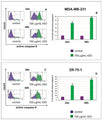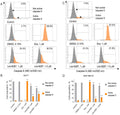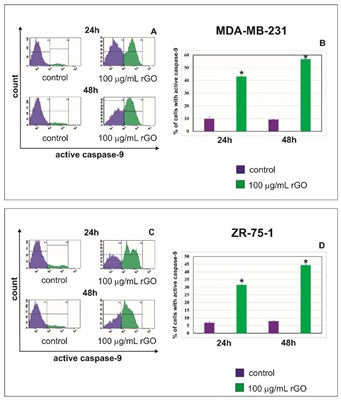Ships: 1-2 business days
- Prepare samples and controls
- Dilute 10X Apoptosis Wash Buffer 1:10 with diH20.
- Reconstitute FLICA with 50 μL DMSO.
- Dilute FLICA 1:5 by adding 200 μL PBS.
- Add diluted FLICA to each sample at 1:30 (e.g., add 10 μL to 290 μL of cultured cells).
- Incubate approximately 1 hour.
- Remove media and wash cells 3 times: add 1X Apoptosis Wash Buffer and spin cells.
- If desired, label with additional stains, such as Hoechst, Propidium Iodide, 7-AAD, or an antibody.
- If desired, fix cells.
- Analyze with a fluorescence microscope, fluorescence plate reader, or flow cytometer. FAM FLICA excites at 492 nm and emits at 520 nm.
If working with adherent cells, please see the manual for additional protocols.
Kit 912: 25 Tests
FLICA Caspase-9 Reagent (FAM-LEHD-FMK), 1 vial, #677
10X Apoptosis Wash Buffer, 15 mL, #635
Fixative, 6 mL, #636
Propidium Iodide, 1 mL, #638
Hoechst 33342, 1 mL, #639
Kit Manual
Kit 913: 100 tests
FLICA Caspase-9 Reagent (FAM-LEHD-FMK), 4 vials, #677
10X Apoptosis Wash Buffer, 60 mL, #634
Fixative, 6 mL, #636
Propidium Iodide, 1 mL, #638
Hoechst 33342, 1 mL, #639
Kit Manual
Product Specific References
| PMID | Publication |
| 39199694 | Finiuk, N., et al. 2024. The Proapoptotic Action of Pyrrolidinedione-Thiazolidinone Hybrids towards Human Breast Carcinoma Cells Does Not Depend on Their Genotype. Cancers, . |
| 38791473 | Krętowski, R., et al. 2024. The Synergistic Effect of Reduced Graphene Oxide and Proteasome Inhibitor in the Induction of Apoptosis through Oxidative Stress in Breast Cancer Cell Lines. International journal of molecular sciences. |
| 36768675 | Rok, J., et al. 2023. The Assessment of the Phototoxic Action of Chlortetracycline and Doxycycline as a Potential Treatment of Melanotic Melanoma—Biochemical and Molecular Studies on COLO 829 and G-361 Cell Lines. International Journal of Molecular Sciences, 2353. |
| 36768363 | Krętowski, R., et al. 2023. The Effect of Silica Nanoparticles (SiNPs) on Cytotoxicity, Induction of Oxidative Stress and Apoptosis in Breast Cancer Cell Lines. International Journal of Molecular Sciences, 2037. |
| 37001390 | Ivasechko, I., et al. 2023. Molecular design, synthesis and anticancer activity of new thiopyrano[2,3-d]thiazoles based on 5-hydroxy-1,4-naphthoquinone (juglone). European journal of medicinal chemistry, 115304. |
| 37763082 | Mańka, S., et al. 2023. Cytotoxic Activity of Melatonin Alone and in Combination with Doxorubicin and/or Dexamethasone on Diffuse Large B-Cell Lymphoma Cells in In Vitro Conditions. Journal of Personalized Medicine, 1314. |
| 35055021 | Rok, J., et al. 2022. The Anticancer Potential of Doxycycline and Minocycline-A Comparative Study on Amelanotic Melanoma Cell Lines. International journal of molecular sciences. |
| 34994998 | Chiu, Y.J., et al. 2022. Curcumin suppresses cell proliferation and triggers apoptosis in vemurafenib-resistant melanoma cells by downregulating the EGFR signaling pathway. Environmental toxicology. |
| 35270004 | González-Sarrías, A., et al. 2022. Milk-Derived Exosomes as Nanocarriers to Deliver Curcumin and Resveratrol in Breast Tissue and Enhance Their Anticancer Activity. International journal of molecular sciences. |
| 35640691 | Ophélie, G., et al. 2022. Cellular and molecular mechanisms of NiONPs toxicity on eel hepatocytes HEPA-E1: An illustration of the impact of Ni release from mining activity in New Caledonia. Chemosphere, 135158. |
| 35467089 | Kubiak, A.B., et al. 2022. The influence of venetoclax, used alone or in combination with cladribine (2-CdA), on CLL cells apoptosis in vitro: Preliminary results. Advances in clinical and experimental medicine : official organ Wroclaw Medical University. |
| 35842415 | Trugilho, M.R.O., et al. 2022. Platelet proteome reveals features of cell death, antiviral response and viral replication in covid-21. Cell death discovery, 324. |
| 36012549 | Krętowski, R., et al. 2022. The Reduced Graphene Oxide (rGO) Induces Apoptosis, Autophagy and Cell Cycle Arrest in Breast Cancer Cells. International journal of molecular sciences. |




